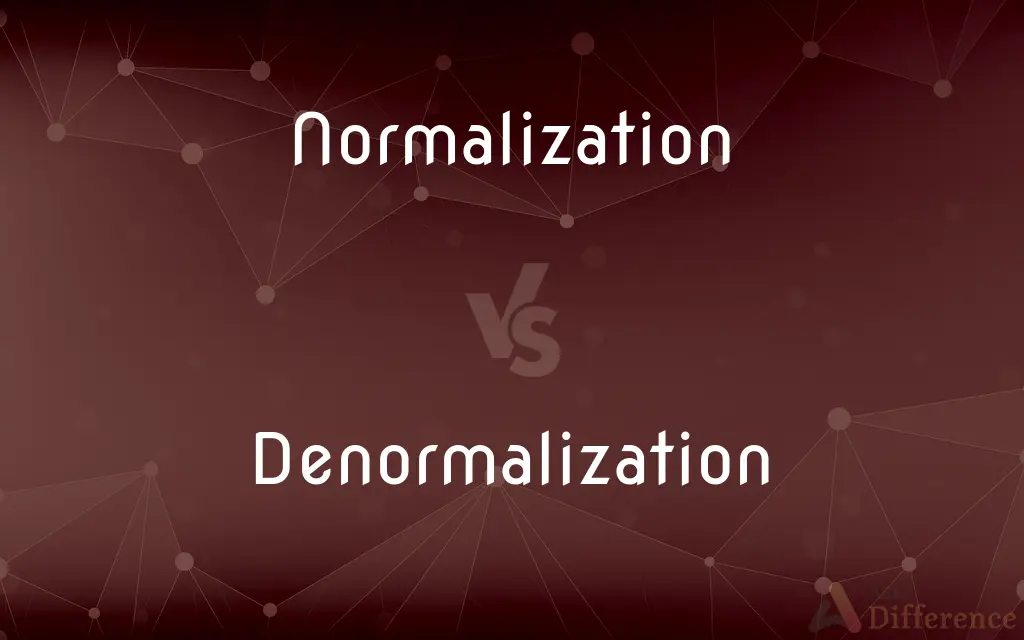Normalization vs. Denormalization — What's the Difference?
By Tayyaba Rehman — Updated on September 19, 2023
Normalization organizes data to reduce redundancy and improve integrity, while Denormalization intentionally introduces redundancy for faster queries.

Difference Between Normalization and Denormalization
Table of Contents
ADVERTISEMENT
Key Differences
Normalization is a structured technique employed in database design to minimize data redundancy and dependency by organizing data into separate tables based on relatedness. Conversely, Denormalization is the process where one purposely introduces redundancy in a database by merging tables, aiming for faster query performance.
In Normalization, tables are structured in such a way that they are less prone to anomalies when undergoing insert, update, or delete operations. On the other hand, Denormalization may make databases more prone to anomalies but will typically improve read speeds.
The primary goal of Normalization is to enhance the consistency and integrity of data. With Denormalization, the focus shifts from ensuring data integrity to optimizing read-heavy operations at the expense of increased storage.
Normalization usually results in more tables in a database, making the structure complex but well-organized. In contrast, Denormalization often results in fewer tables, which can be larger and more cumbersome but more efficient for specific querying tasks.
When using Normalization, developers aim for balance, ensuring that the data structure supports the efficient execution of the most frequent tasks. With Denormalization, the focus is on specific performance needs, sometimes at the expense of using more storage space and complex update operations.
ADVERTISEMENT
Comparison Chart
Purpose
Reduce data redundancy and improve data integrity.
Improve query performance by introducing redundancy.
Table Structure
Results in more tables, but with minimal redundancy.
Leads to fewer, but larger tables with potential redundancy.
Performance
Can lead to slower query performance due to joins.
Typically faster for read-heavy operations.
Data Anomalies
Reduced chances of anomalies.
Increased risk of data anomalies.
Storage
Efficient storage as redundancy is minimized.
May use more storage due to intentional redundancy.
Compare with Definitions
Normalization
Organizing database to reduce redundancy.
Through Normalization, the team achieved a streamlined database structure.
Denormalization
Combining multiple tables into a single one for simplicity.
Through Denormalization, several tables were merged into a comprehensive one.
Normalization
Structuring to reduce insertion, update, and deletion anomalies.
Using Normalization, anomalies were drastically reduced.
Denormalization
Sacrificing some data integrity for better performance.
Denormalization was chosen to prioritize querying over perfect integrity.
Normalization
Efficiently using storage by reducing repeated data.
Thanks to Normalization, the database utilized storage optimally.
Denormalization
Introducing redundancy for faster data retrieval.
Denormalization improved the query speeds substantially.
Normalization
To make normal, especially to cause to conform to a standard or norm
Normalize a patient's temperature.
Normalizing relations with a former enemy nation.
Denormalization
Design choice for databases with frequent data reads.
Considering the app's read-heavy nature, Denormalization was apt.
Normalization
To cause (something previously regarded as anomalous) to be accepted as normal, thereby altering the accepted norm
“The increased visibility of Iraq War amputees has helped normalize the use of prostheses” (Bruce Barcott).
Denormalization
Uses more storage due to the redundancy.
The Denormalization process required additional storage space.
Normalization
To make (a text or language) regular and consistent, especially with respect to spelling or style.
Denormalization
Denormalization is a strategy used on a previously-normalized database to increase performance. In computing, denormalization is the process of trying to improve the read performance of a database, at the expense of losing some write performance, by adding redundant copies of data or by grouping data.
Normalization
To remove strains and reduce coarse crystalline structures in (metal), especially by heating and cooling.
Denormalization
The act or process of denormalizing.
Normalization
To become or return to normal
Waiting for diplomatic relations to normalize.
Normalization
Any process that makes something more normal or regular, which typically means conforming to some regularity or rule, or returning from some state of abnormality.
Normalization
Standardization, act of imposing standards or norms or rules or regulations.
Normalization
(databases) In relational database design, a process that breaks down data into record groups for efficient processing, by eliminating redundancy.
Normalization
(diplomacy) Process of establishing normal diplomatic relations between two countries.
Normalization
(economics) Globalization, the process of making a worldwide normal and dominant model of production and consumption.
Normalization
(operations) Normalized production. en
Normalization
(politics) Sharing or enforcement of standard policies.
Normalization
(sociology) A process whereby artificial and unwanted norms of behaviour and models of behaviour are made to seem natural and wanted, through propaganda, influence, imitation and conformity.
Normalization
(statistics) The process of removing statistical error in repeated measured data.
Normalization
(politics) Peace efforts and treaties between the Arab League and Israel. See Arab–Israeli normalization.
Normalization
Reduction to a standard or normal state.
Normalization
The imposition of standards or regulations;
A committee was appointed to recommend terminological standardization
Normalization
Design method to maintain data accuracy and consistency.
Normalization ensured high data integrity for the project.
Normalization
Organizing data into distinct tables based on relationships.
The Normalization process led to the creation of several specific tables.
Common Curiosities
What is the main aim of Normalization?
The primary aim of Normalization is to minimize redundancy and improve data integrity in databases.
Can Denormalization lead to data inconsistency?
Yes, introducing redundancy with Denormalization can lead to potential data inconsistencies.
Is Denormalization always the solution for slow queries?
Not always. While Denormalization can improve query speeds, it's essential to weigh its benefits against increased storage needs and potential data anomalies.
When should one consider Denormalization?
Consider Denormalization when query speed is a priority, especially in read-intensive applications.
Why is Denormalization used?
Denormalization is used to improve query performance, especially in read-heavy database systems.
Can a database be both normalized and denormalized?
Yes, specific parts of a database can be normalized, while others are denormalized, depending on performance needs.
Does Normalization always lead to better data integrity?
While Normalization aims for data integrity by reducing redundancy, it doesn't guarantee complete absence of errors.
Why might one avoid excessive Normalization?
Excessive Normalization can make queries slower due to the need for multiple table joins.
Can Normalization help in understanding data relationships?
Yes, Normalization organizes data based on relationships, offering a clear view of how data entities relate.
How does Normalization affect storage?
Normalization often leads to more efficient storage use by minimizing data redundancy.
Is Denormalization the opposite of Normalization?
Not exactly. While they are contrasting processes, Denormalization is more about optimizing for specific use cases rather than reversing Normalization.
Is Denormalization suitable for all types of applications?
No, Denormalization is best for specific applications where read operations dominate and performance is critical.
Can a well-normalized database still have performance issues?
Yes, even with a well-normalized structure, other factors like inefficient queries or hardware limitations can affect performance.
Does Normalization always increase the number of tables?
Often, but not always. Normalization aims to organize data efficiently, which often results in separating data into distinct tables.
How does Denormalization affect updates?
Denormalization can make updates more complex and time-consuming due to data redundancy.
Share Your Discovery

Previous Comparison
Superfluous vs. Redundant
Next Comparison
Thermostat vs. HygrostatAuthor Spotlight
Written by
Tayyaba RehmanTayyaba Rehman is a distinguished writer, currently serving as a primary contributor to askdifference.com. As a researcher in semantics and etymology, Tayyaba's passion for the complexity of languages and their distinctions has found a perfect home on the platform. Tayyaba delves into the intricacies of language, distinguishing between commonly confused words and phrases, thereby providing clarity for readers worldwide.














































